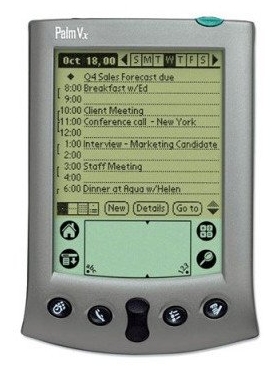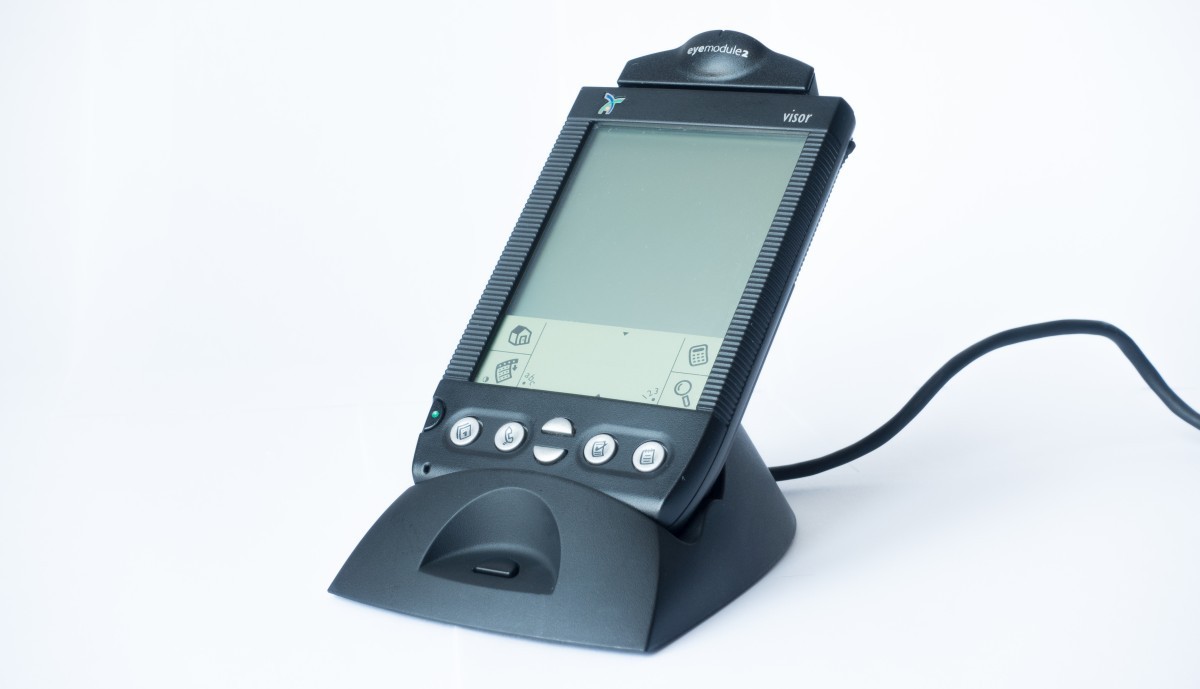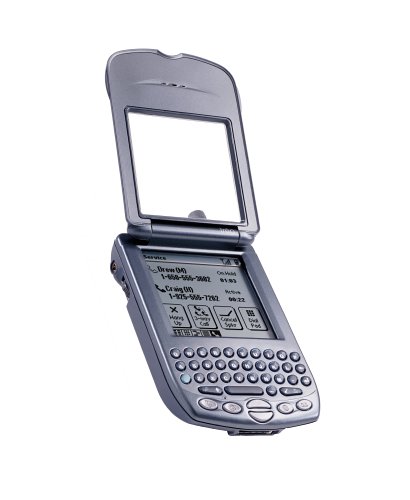Antiquities: Three Stories about the Palm Company
 This company has changed a dozen titles, but let's just use the very first, original one. Palm Computing usually evokes the warmest feelings among computer amateurs, and at one time its handheld computers were, in a sense, the default choice. The history of Palm can be divided into three parts: the era of classic handheld computers, the era of early smartphones and the
This company has changed a dozen titles, but let's just use the very first, original one. Palm Computing usually evokes the warmest feelings among computer amateurs, and at one time its handheld computers were, in a sense, the default choice. The history of Palm can be divided into three parts: the era of classic handheld computers, the era of early smartphones and the But this is a division by device, and today I want to tell you about the people and circumstances of the creation of these devices. I chose three stories about the golden period of Palm in particular and the Palm OS ecosystem in general - until 2003. And I want to start with prehistoric times, when the Palm OS already existed, but it was still far to the familiar handhelds. As in the case of Apple, one of its founders, Jeff Hawkins, who is responsible for both ups and downs, played a significant role in the development of Palm.
I keep the diary of the collector of old pieces of iron in real time in the Telegram .
Casio Zoomer or endless meeting development
Jeff Hawkins didn’t plan to become the creator of the first truly massive handheld computer. Moreover, he was not going to lead a startup. He was always interested in the principles of the brain and what is now called machine learning systems. In 1979, he graduated from Cornell University with an engineering degree, but ended a successful career in 1986, enrolling at the University of California at Berkeley, with a degree in biophysics. But it did not work out there either. Hawkins did not see himself as a researcher, and wanted to implement his ideas in a business environment, to create a commercial product that can be sold for money.
')
In 1989, at the age of 34, he returned to his previous job - to GRiD Systems , which created the first portable computer, and at the end of the 80s - pioneered the market for “pen-input computers”. GRiDPad was the progenitor of modern tablets, only weighing two kilograms and worth $ 3,000 (more than 6000 in modern money).

The device was successful in narrow circles: with such a price tag it was bought only by corporations, and a little more - by state structures and the army. In the early nineties, “pen computing” was the same hot topic as the blockchain and augmented reality is now, but the time for mass production of such devices has not yet come. Nevertheless, the handwriting recognition system first appeared in GRiDPad, which later evolved into a proprietary input system on all Palm trees under the name Graffiti. In 1991, Hawkins is trying to sell the idea of a miniature computer for the masses to the leadership, but is failing - a B2B-oriented company does not want to get involved in retail sales.
Negotiations are underway with the owner of GRiD Systems, the Tandy company, known to all US residents for its network of RadioShack radio equipment stores. The idea of a handheld computer was supported, but Hawkins did not want to work on a breakthrough product as part of the “old school” corporate structure of the old-fashioned minicomputer manufacturer from Texas. As a result, the same startup turned out: sponsored by venture funds and the same Tandy, he promised the founder a certain level of independence.
Independence did not work. Before the trip to Tandy headquarters, the founder of Palm wrote a short description of the device, “which by the end of the decade will be distributed just like calculators today”. It was necessary to come up with a name, and practically from the ceiling the project was given the name “Zoomer”. So it later went into production. The Casio Zoomer PDA was a developer’s nightmare and survived a fantastic market failure: The Zumers sold ten times less than the Apple Newton PDA (even though it was a failed product itself).
It can be said that Zoomer was the victim of a “design committee”. The Japanese Casio, the partner of Tandy, and at that time mostly an expert on watches and thus calculators, were responsible for the iron. She made to the handheld computer "calculator" requirements like 100 hours of battery life, which led to the choice of too low-power processor. GeoWorks was responsible for developing the operating system, and for her it was also the first hike on the rake of mobile computers. Newborn Palm Computing handwriting recognition system and user software; and worked in parallel with GeoWorks, that is, each new build of the OS and applications threatened to break each other.
Disturbing calls about bugs came from Japan, mainly at night because of the time difference (if you click there ten times, it does not work here). Software developers felt like contractors with an iron maker who doesn't understand that bugs happen, and this is normal. As a result, in 1992, not the best device turned out - an expensive ($ 700), braking device, limited in capabilities. But, considering the failure of a more prosperous Apple in the same field, it can be assumed that the time has not just come.
Palm Pilot and trademark passion
From the history of the project Zoomer was extracted and useful experience, and some income. The handwriting recognition system has become a commercial product for the Apple Newton PDA. Palm earned the development of software for synchronizing portable devices HP. It became clear, however, that it would not be possible to avoid developing own iron, and this required serious investments. The first proprietary handheld computer, called the Pilot 1000, was released in 1996. Already in the course of working on Zoomer, both the team (executive director Donna Dubinsky, marketer Ed Colligan, developers) and the principles of work, the very Zen of Palm, a combination of reasonable minimalism and attention to detail, took shape. Hawkins experimented with wooden mockups of the first of his own PDAs, dragged them in his pocket all day and imagined how he entered the text with the stylus.

In early 1996, Palm organizes a road show and meets with "opinion leaders" - journalists and analysts. Pilot is advertised as a “companion for a personal computer,” an easily mastered tool for a person “who wants to keep order in business and is constantly moving.” Impressions of the press are positive, but the reviews are caustic, in the actual for this time style tired of technological innovations of the leading lights. “Why is there no modem?” “Where is the PCMCIA slot?” “What about wireless?”. It always seems to us that promising technologies are about to become a new standard, but in fact, even a developed new product and its actual use pass both years and decades. Well, what wireless Internet in 1996? At that time, the Pilot’s design (monochrome screen, 16 MHz processor, 128 or 512 kilobytes of memory), its capabilities (contacts, calendar, notes, to-do list) and price ($ 300) perfectly matched the era. The first models did not even have the backlight!
PalmPilot became a successful product, having occupied 70% of the market by the end of 1996, but this does not mean that its launch went without problems. The company was sued by the Japanese manufacturer of pens Pilot Pen . I had to negotiate, and since 1998, “palm trees” have ceased to be called “pilots”. This is not the last trial: in 2003, the Graffiti handwriting system had to be redone due to a Xerox suit.
And it is not only in litigation. In the production process, bugs were found that could put the company on the brink of survival. The springs supporting the batteries in the device were wrinkled and resulted in loss of contact: in the device without backup power, this was equal to the loss of all data from simple shaking. Already on the conveyor a hardware bug was found in the Motorola processor, for it I had to write a software patch that bypasses the problem. At an important presentation for the company at the Demo '96 conference, Hawkins showed “Pilot” to representatives of the industry, it was important to make a good impression. The founder of the company goes on stage, takes the device out of his pocket (approving sighs in the hall), puts it on the projector, and at that moment the screen goes blank. Hawkins, trying to defuse the situation, asks the chief marketing officer, Ed Collingan, if he has a suitable joke. Ed replies: "Yes, something is not funny at all to me now."
So they worked.
Mergers and Acquisitions
The company Palm for a long time could not become independent and the expected difficulties of developing new devices were added corporate squabbles. In 1995, Palm becomes a division of US Robotics, a well-known manufacturer of consumer and corporate modems. At that time, this business was close to dusk, and Palm alternately considered it a bright future, then an unnecessary ballast, which should be cut funding. In June 1997, US Robotics, together with Palm, was sold to 3com, a moment to a major network equipment manufacturer. Palm CEO Donna Dubinsky already in the course of the merger of the two companies demanded to make her company independent.

The reason was the difference in approaches: Palm, despite the good first sales of the PDA, was still in the status of a startup with two hundred employees. 3com was a huge conglomerate, rather cumbersome and with traditional ideas about rewarding employees. The company could only attract the best developers in the era of the emerging boom of investment in IT and dotcoms with options, company stocks that could theoretically bring in millions if they went public. 3com management had its own priorities: merging two large companies is a difficult task, especially if both are not in the best shape. Having been refused both to the spin-offs, and to the option program inside 3com, the founders of Palm leave the company they created, and create a new one - Handspring (after making sure that no one claims the exact name).

Left without founders (and some of the employees, and for the first few months, without any leadership at all), Palm was nevertheless separated into a separate company and was listed on the stock exchange in 2000. In 2002, the company was divided into two: just Palm was engaged in hardware, and the new PalmSource - in software. It was an attempt to increase the market share of the Palm ecosystem: an independent OS vendor is more attractive for third-party vendors. In 2003, Palm merged with Handspring and became known as PalmOne, the founders returned to their company just as Steve Jobs returned to Apple in 1997.

All these corporate overtures were executed with the best intentions, but we know perfectly well that the more often reorganizations occur, the less time is left for real work. However, the outcome of the Palm management on free breads led to the emergence of a fundamentally new device based on already developed technologies: the Handspring Treo smartphone. Released in 2002, the Treo 180 monochrome model provided a foundation for the future, which Palm / Handspring / PalmOne / Palm was never able to fully realize.

Leaving Palm in 1998, executive director Donna Dubinsky tried to support the spirit of the heads of the divisions remaining on the ship with words about a stock of ideas and projects, which the company will have enough for a couple of years even without sensible leadership. This is what happened. In 1999, perhaps the best classic Palm OS based PDA was released - the Palm V model.

For a collection to last for a long time, it is best to buy a “palm tree” on batteries, but the incredibly thin compared to its predecessors, the Palm V impresses with subtlety and elegance. The design, created by Hawkins before leaving Palm, experienced several reincarnations, including the Palm m500 series, first equipped with an SD / MMC card slot. Handspring at the same time did a bit more brutal models, but they had an expansion slot for additional memory and for expanding functionality. Read more about PDA Handspring I wrote here .
It is clear that later there were colored PDAs, and more powerful ones, but the real classic of “palm building” is such. Slim body, square monochrome screen, the ability to work on a single battery charge for weeks, almost instantaneous response to any user actions. But at the same time - almost complete inability to the Internet, even in the form in which it was available at the beginning of the two thousandth.
Despite the difficulties in business and technology, the golden era of Palm handheld computers is a monochrome era. In 2003, it seemed to them that all the difficulties were behind: the company was finally independent, the founders were at the helm again, they had vast experience in developing portable devices, smartphones appeared in the product line. In fact, the main tests were ahead: this forced refusal of further use of the Palm OS, despite the already ready multi-tasking version of the system, known as Palm OS Cobalt. This is the transfer of smartphones to Windows, and attempts to write from scratch your own mobile platform for modern requirements - both successful and not so much. I still have to study this part of the history of Palm, and understand how it happened that the company was acquired by HP in 2010, almost simultaneously with 3com that once owned it, and rather quickly ceased to exist.

It will be a difficult study. The early history of Palm is described in detail in the book Piloting Palm , from which I took a few quotes for this article. This detailed and fascinating story was written by people who worked at Palm and truly loved their company, although they had to leave it together with the founders. It ends just at the development of the Palm Treo. This is the best moment for a happy end: behind the incredible history of classic PDAs, there is a bright future for mobile devices always connected to the cellular network. It’s a pity that Palm didn’t work: today, in 2019, I would be happy to have a strong competitor to the modern mobile platforms Apple and Google.
Source: https://habr.com/ru/post/457008/
All Articles